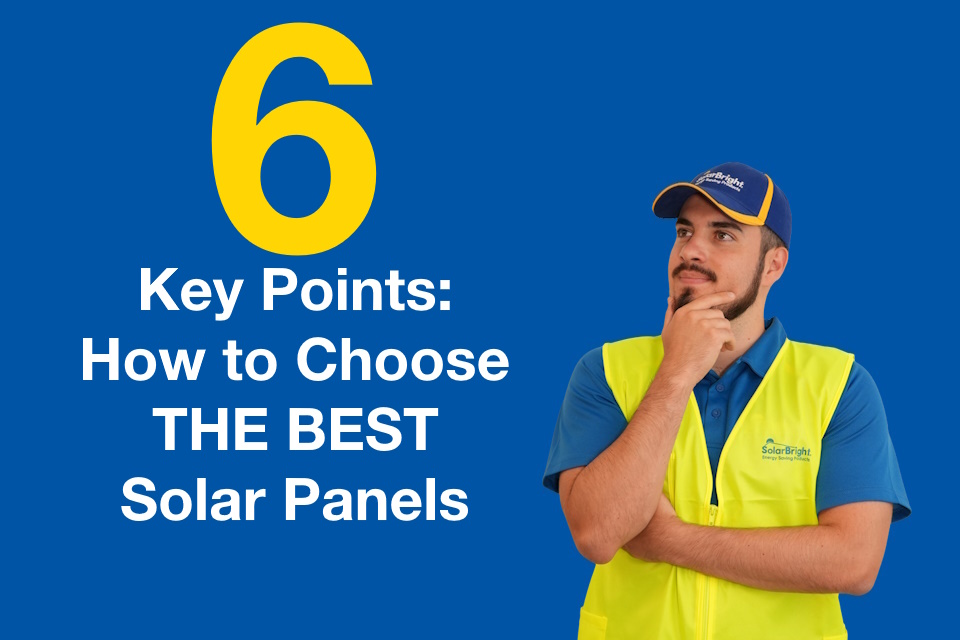Solar Battery, Solar Battery Reviews
Sungrow SBR Battery Review
The Sungrow SBR battery has become one of Australia’s favourite home energy storage options.…

Many customers approach me asking how to choose the best solar panels. They will be investing in a solar system and want to be sure to choose the right panels for longevity and performance. In a market overflowing with options, they need to know what to look for.
So based on my experience on the solar industry here is a quick guide. This will help you navigate the competing salespeople and products to help you choose the best solar panels for you.
Solar panels are made with either N-Type (Negative Type) or P-Type (Positive Type) silicon cells. While P-Type panels are cheaper and more widely available, N-Type panels are the superior technology.
N-Type panels are more efficient, generate more electricity in lower light, manage higher temperatures and harsher conditions, and have lower degradation rates. They may cost more, but N-Type panels are the best investment for their performance and durability.
Whether it’s sun, tropical rain, or fierce winds, you need solar panels that will withstand the harsh Australian climate.
Standard panels are made with a plastic backing sheet that can delaminate over time allowing moisture seep in and damage the panel. Dual glass technology means the panels have front and rear glass panels. This offers better protection and strength, increasing the durability and longevity of the panel.
If your site has reflective or light-coloured surfaces, bifacial solar panels help you maximise your energy output. Bifacial panels have solar cells on both sides, meaning they generate power from direct sunlight hitting the front and reflected light hitting the back of the panel. This increases the amount of light captured and boosts your energy production.
Efficiency refers to how much sunlight a panel converts into electricity. Higher efficiency panels generate more power per square metre, making them ideal for homes with limited roof-space. The best solar panels on the market have an efficiency rating of above 20%.
Solar panels need the sun, but sometimes it can be a case of too much of a good thing. Panels generate less power as they get hotter. The temperature co-efficient of Pmax indicates the decrease in your power output for every degree the temperature goes above 25°C. A lower temperature co-efficient means better performance in hot conditions. Choose a panel with a temperature co-efficient below -0.35% per degree Celsius for optimal efficiency and performance in Australia’s high temperatures.
All solar panels experience a reduction in output over time. Higher quality panels degrade at a slower rate, meaning the panel produces more power over its life span. Look for a panel with a degradation rate of less than 0.5% per year. At that rate, it will still be producing 85% of its original capacity after 30 years.
Warranties are a strong indicator of panel quality. The best solar panels come with two types of warranties:
Some homeowners value aesthetics, seeking out black-frames or black-cells, as they look more modern, sleek and blend in with most rooftops. The good news is that these panels are both visually appealing and use high quality materials. So, there’s no need to trade-off between looks and quality.
The best solar panels come from all over the world, with leading brands coming out of China, Vietnam, India, Thailand and the US.
When it comes to production China can’t be beaten, producing in 2023 85% of the world’s solar panels. China leads in affordability and technological advancements. They produce large quantities of cutting-edge technology at competitive prices. Many Chinese panels not only compete with, but outperform, European or American brands. All panels coming into the Australian marketing must be certified by the CEC.
Experiencing an information overload in choosing the best solar panel? It can all be boiled down to a simple 6-point checklist:
Once you’ve found the best solar panels for your system, all that’s left is to find the right solar installer. You need someone reliable, who will provide after-sales support and handle any future warranty claims.
Avoid man-in-a-van installers or large retailers operating out of overseas call centres, chances are you’ll never hear from them again when you need their help.
Look for a solar installer with a physical business location you can visit. Quality installers will also offer a site inspection prior to installation. If they do not, go elsewhere. A reputable installer will offer ongoing service, maintenance, and future assistance.
Now you’re ready to confidently invest in a solar system that will deliver on performance, longevity, and a return on investment. To see what solar system or solar and battery system would best suit you, call SolarBright today and talk to one of our solar experts.
Take a Look
Solar Battery, Solar Battery Reviews
The Sungrow SBR battery has become one of Australia’s favourite home energy storage options.…
Solar Battery, Skylights, Solar Panels, Roof Ventilation, Solar Inverter
Solar energy is a renewable, clean energy source from the sun. It is the…
Solar Battery Reviews
If you’ve been looking into solar batteries, you’ve probably heard the name Sungrow pop…